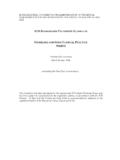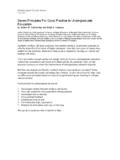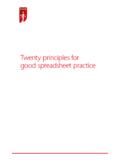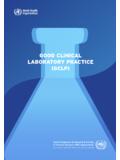Transcription of INTEGRATING WORK AND LEARNING - ASET
1 ASET good Practice Guide for work based and Placement LEARNING in Higher EducationAS TINTEGRATING work AND LEARNING Acknowledgements ASET has been involved in promoting good Practice around placements since 1982, the terminology then was sandwich education, and limited to the year students would spend in the workplace as part of their university education, but now the broader term work based and placement LEARNING (WBPL) is used to fully encompass the breadth of opportunities available to students, irrespective of their level or mode of study. ASET s goal remains the same; to advance the prevalence, effectiveness and quality of work based and placement LEARNING in Higher Education. Thanks must go to all those in the ASET community for their contributions for this good Practice Guide, both directly and indirectly.
2 The delegates of the 2012 ASET Conference gave willingly of their ideas, questions and suggestions for this update. It only goes to demonstrate the power of a community of practitioners when we work together for the better of all. This Guide was prepared by: Dr John Wilson, Chair of ASET Sarah Flynn, Vice Chair of ASET and Principal Lecturer, University of Hertfordshire Dr Anett Loescher, Development Officer at the Quality Assurance Agency Tim Ward, work Experience Consultant, University of Salford Debbie Siva-Jothy, Company Administrator, ASETThe authors are grateful for the comments and revisions of the ASET Executive Committee; Allison Dunbobbin (Loughborough University), Rebecca Evans (University of Leeds), Megen Hartley-Clarke (Sheffield Hallam University), Dr Douglas McCulloch (University of Ulster), Amanda Monteiro (London South Bank University), Debbie Scott (University of Chester), Tamsin Turner (Queen s University Belfast), Dr Colin Turner (University of Ulster), Dr Ray Wallace (Nottingham Trent University), Lisa Ward (University of Huddersfield)Thanks must also go to the Quality Assurance Agency for their input, advice and suggestions during the production of this Guide, particularly Dr Anett Loescher.
3 For more information about ASET please see ASET and Contributors, September 2013 ContentsIntroductionWho is this Guide for?Purpose of this Guide Sound Practice and good Practice Relationship between this good Practice Guide and the Quality CodeFitness for purposeWork Based and Placement LearningTerminologyPrinciples of good Practice ConclusionKey ReferencesPre-PlacementOn PlacementPost-PlacementHistory of this GuideSummary of UK the Quality Code for Higher Education (Quality Code)444556781015151620232626 Introduction The focus in this Guide is for work based and placement LEARNING opportunities that are a planned and integrated part of a student s programme of study at a Higher Education provider. It is intended to be useful to practitioners irrespective of the level or mode of study, the academic subject, whether work based or placement LEARNING (WBPL).
4 This Guide has been written to support the development of good Practice , but is neither prescriptive nor regulatory. WBPL is important in that it helps to bring together academic theory and workplace practice, INTEGRATING the working with the LEARNING . It might be about increasing a student s employability, but may also be a defining characteristic of a qualification and therefore must be considered in the same manner as other forms of LEARNING , teaching and assessment when it comes to quality and standards in Higher is this Guide for? All practitioners in Higher Education associated with work based and placement LEARNING ; this includes but is not limited to: Professional and administrative staff Academic tutors Careers Services Resource ManagersSpecific sections may be usefully shared by practitioners with their students and employers providing work based and placement LEARNING of this GuideASET has worked with the Quality Assurance Agency to ensure that this good Practice Guide assists practitioners in setting up provision and processes for planning, managing, monitoring and evaluating work based and placement LEARNING .
5 That enables them to consider how they will demonstrate that their practice is Sound , in accordance with the benchmarks agreed by the academic community and that are expressed in the Expectations of the UK Quality Code for Higher Education (Quality Code) that gives a simple approach with a commitment to continuous enhancement, by providing guiding principles that can be used in the development of good Practice, which may and should evolve over time4 Sound Practice and good PracticeThis Guide uses the terms Sound Practice and good Practice and it is important to be clear on the difference between the two. Sound Practice , as used in the Quality Code, means that the practice is robust, fit for purpose, and should be embraced by any Higher Education provider Sound Practice sets a benchmark, acting as a starting point for enhancing the quality of practice, and is less vulnerable to becoming out dated or overtaken by developments in the field good Practice builds on Sound Practice and may include innovative, outstanding or cutting-edge examples As good Practice becomes embedded.
6 It can become standard practice Therefore this Guide is accompanied by a dynamic toolkit which will support development of what is good Practice across the sectorRelationship between this good Practice Guide and the Quality CodeThe Quality Code consists of three parts A, B and C. It is a holistic document which needs to be appreciated in its entirety. The Expectations of the Quality Code are mandatory; the Indicators of Sound Practice provide useful signposts as to how a Higher Education provider can demonstrate that it meets the Expectations. If providers are considering work based and placement LEARNING in preparation for a review, the reference point must be the Quality Code itself and not the principles within this should appreciate the Quality Code in its entirety, although they may find the Indicators of Sound Practice and explanatory guidance of the following chapters particularly helpful when developing or delivering a programme which includes work based or placement LEARNING : B3.
7 LEARNING and teachingThis chapter focuses on the LEARNING opportunities that Higher Education providers make available to students, and on the staff who teach and/or support LEARNING , including staff that are not employees of the Higher Education provider and/or are not based at the provider. B3 should be helpful for practitioners in appreciating the resources, environment, experiences and stakeholder responsibilities required for placement LEARNING opportunities B4: Enabling student development and achievementThis chapter addresses the ways in which Higher Education providers enable students to develop and achieve their academic, personal and professional potential. Students who are fully informed about the opportunities available to them, but who are also aware of5their responsibility to engage with those opportunities, are more likely to make effective use of services and resources.
8 B4 should be helpful for practitioners in appreciating the support required for placement LEARNING and the contribution it makes to the wider student experience B10: Managing Higher Education provision with othersThis chapter addresses the planning, establishing, managing and monitoring of Higher Education where it is delivered with or by others. B10 should be helpful for practitioners in appreciating the nature, complexity, and potential issues in any arrangements with placement providers, and should help in establishing a sound management frameworkPractitioners might also find the guidance in B6: Assessment of students and accreditation of prior LEARNING and in Part C: Information about Higher Education provision helpful when developing and establishing Education providers reviewed by the QAA are required to meet all the Expectations of the Quality Code.
9 The manner in which they do so is their own responsibility; it is important that providers respond in the ways that are appropriate for their organisation, internal structures and the range of work based and placement LEARNING opportunities that they offer. Providers are also responsible for meeting the requirements of legislation and any other regulatory requirements placed upon them, for example by funding councils or Professional, Statutory and Regulatory Bodies (PSRB). This Guide should be read alongside these legislative requirements and reference points; and not in lieu of them. Fitness for purposeThe emphasis should always be on fitness for purpose. Throughout this Guide we use the expressions continuum and proportionate; and due to the wide range of work based and placement LEARNING found in Higher Education we must acknowledge that these opportunities are distributed along a spectrum, both in terms of length and integration to the curriculum.
10 Consequently we need to think of good Practice as a continuum, as shown in the figure overleaf, and what is thought of as good Practice for a very short insight day may look quite different from that which is required for a practice placement hence the need to be proportionate. 6 work Based and Placement LearningThe objective of any work based or placement LEARNING experience, regardless of length, is to consolidate and complement the academic LEARNING , knowledge and skills with experience. It generally involves a three-way partnership involving student, employer and Higher Education provider, and this Guide suggests good Practice for each party, in terms of roles, entitlements and responsibilities. It is important to remember that irrespective of who initiates the placement; whether a student makes a speculative application, an employer advertises a scheme or a Higher Education provider sources a project, it is important that all three parties are brought into the relationship in order that it becomes a successful LEARNING opportunity.







